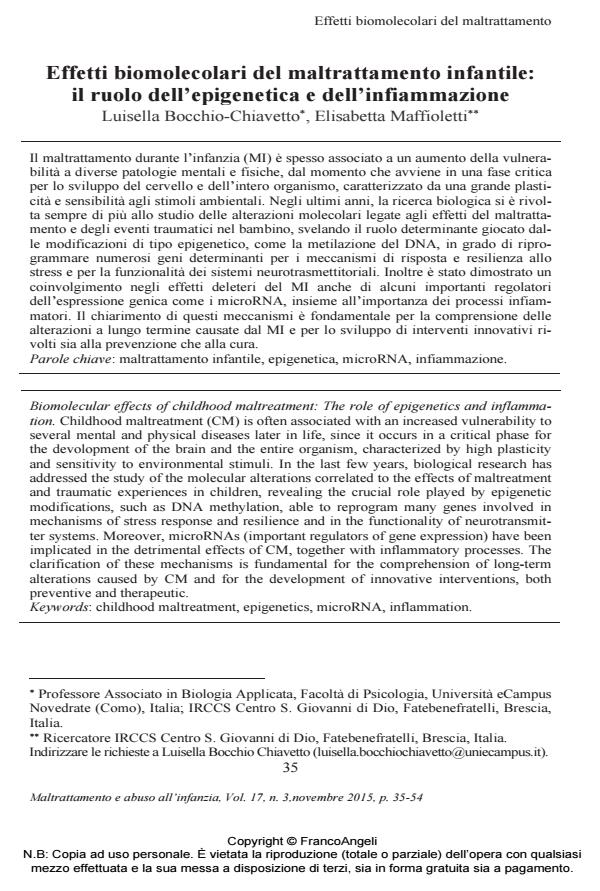Biomolecular effects of childhood maltreatment: The role of epigenetics and inflammation
Journal title MALTRATTAMENTO E ABUSO ALL’INFANZIA
Author/s Luisella Bocchio-Chiavetto, Elisabetta Maffioletti
Publishing Year 2015 Issue 2015/3
Language Italian Pages 20 P. 35-54 File size 148 KB
DOI 10.3280/MAL2015-003003
DOI is like a bar code for intellectual property: to have more infomation
click here
Below, you can see the article first page
If you want to buy this article in PDF format, you can do it, following the instructions to buy download credits

FrancoAngeli is member of Publishers International Linking Association, Inc (PILA), a not-for-profit association which run the CrossRef service enabling links to and from online scholarly content.
Childhood maltreatment (CM) is often associated with an increased vulnerability to several mental and physical diseases later in life, since it occurs in a critical phase for the devolopment of the brain and the entire organism, characterized by high plasticity and sensitivity to environmental stimuli. In the last few years, biological research has addressed the study of the molecular alterations correlated to the effects of maltreatment and traumatic experiences in children, revealing the crucial role played by epigenetic modifications, such as DNA methylation, able to reprogram many genes involved in mechanisms of stress response and resilience and in the functionality of neurotransmitter systems. Moreover, microRNAs (important regulators of gene expression) have been implicated in the detrimental effects of CM, together with inflammatory processes. The clarification of these mechanisms is fundamental for the comprehension of long-term alterations caused by CM and for the development of innovative interventions, both preventive and therapeutic.
Keywords: Childhood maltreatment, epigenetics, microRNA, inflammation
- Le memorie traumatiche e il corpo: uno studio su maltrattamento infantile, consapevolezza interocettiva e sintomi somatici Luana La Marca, Andrea Scalabrini, Clara Mucci, Adriano Schimmenti, in MALTRATTAMENTO E ABUSO ALL'INFANZIA 3/2018 pp.47
DOI: 10.3280/MAL2018-003004 - Abuse, emotion regulation, and interoception: What can studies on the brain-body interaction tell us? Laura Angioletti, Michela Balconi, in MALTRATTAMENTO E ABUSO ALL'INFANZIA 1/2020 pp.9
DOI: 10.3280/MAL2020-001002 - Maltrattamento e abuso: una rassegna su definizioni, tipologie e interventi per la tutela dei soggetti a rischio Flaviana Tenuta, Maria Giuseppina Bartolo, Daniela Diano, Angela Costabile, in MALTRATTAMENTO E ABUSO ALL'INFANZIA 2/2020 pp.85
DOI: 10.3280/MAL2020-002005
Luisella Bocchio-Chiavetto, Elisabetta Maffioletti, Effetti biomolecolari del maltrattamento infantile: il ruolo dell’epigenetica e dell’infiammazione in "MALTRATTAMENTO E ABUSO ALL’INFANZIA" 3/2015, pp 35-54, DOI: 10.3280/MAL2015-003003